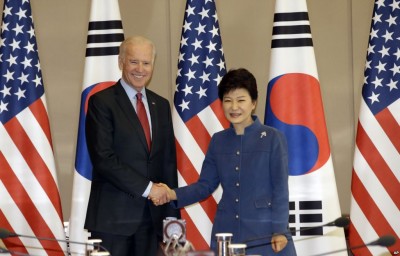US “Pivot to Asia”: South Korea Extends Air Defence Zone to Overlap with China’s

In the wake of US Vice-President Joe Biden’s visit to Asia last week, tensions continue to mount over China’s air defence identification zone (ADIZ) in the East China Sea. Over the weekend, South Korea extended its own ADIZ to overlap with China’s zone, while two other US allies—Australia and Japan—were involved in sharp diplomatic exchanges with China.
The South Korean announcement was made yesterday, after President Park Geun-hye briefed Biden during his visit, which ended the previous day. Korea’s ADIZ now includes a disputed submerged reef, known as Ieodo in South Korea and Suyan Rock in China, that Beijing included in its own zone, announced on November 23. South Korea currently controls the reef and has built a marine research station on it.
South Korea’s ADIZ was originally established 62 years ago in the midst of the Korean War. It has now been expanded for the first time—southward by more than 300 kilometres. The decision affects military aircraft, which will be required to provide advance notification before entering the zone, raising the danger of an aerial confrontation if they fail to do so. The US State Department, which was highly critical of China’s new ADIZ, indicated its support for South Korea’s decision.
By giving the green light for the South Korean ADIZ, Biden has compounded an already tense situation in the East China Sea. The US responded to China’s ADIZ by provocatively flying B-52 bombers into the zone without notifying Chinese authorities. Washington further declared it would back Japan in any conflict with China over several disputed rocky outcrops, known as Senkaku in Japan and Diaoyu in China, which Beijing included in its ADIZ.
In South Korea last Friday, Biden emphasised the Obama administration’s “absolute” commitment to its “pivot to Asia,” aimed at undermining China diplomatically and encircling it militarily. His comments were designed to quell doubts in Asia about the “pivot,” following Obama’s non-attendance at recent key Asian summits, and to reinforce key allies within the region.
The sharpness of tensions was all too evident at a meeting between Australian Foreign Minister Julie Bishop and her Chinese counterpart, Wang Yi, in Beijing last Friday. Ignoring diplomatic niceties, Wang publicly rebuked Australia in front of Chinese and international journalists, declaring that what Canberra had “said and done” over China’s ADIZ had “jeopardised mutual trust and affected the sound growth of bilateral relations.”
Immediately following China’s ADIZ announcement, the Australian government summoned the Chinese ambassador to Canberra for a dressing down, saying the move was “unhelpful in light of current regional tensions, and will not contribute to regional stability.” Speaking at that time, Bishop declared that Australia was opposed to “any coercive or unilateral actions to change the status quo in the East China Sea.”
While clearly surprised by Wang’s remarks last Friday, Bishop did not resile from her government’s condemnation of China’s air defence zone. As journalists were ushered out of the room, she declared: “I must take issue with you on the matter of the East China Sea. We stand by our views and that reflects the importance of peace and stability.” She again insisted “that there be no unilateral actions, nor coercive actions.”
Such public brawling reflects deep antagonism. Wang’s decision to take the unusual step of publicly censuring Bishop is an attempt to push back against the concerted campaign of the US and its allies over the ADIZ. For its part, the new Australian government has already signalled its support for the US military build-up in Asia, opening up further Australian bases for US forces. Canberra’s decision to buy into the ADIZ dispute, thousands of kilometres from Australian shores, underlines its unequivocal backing for the “pivot,” regardless of the consequences of a falling out with its largest trading partner, China.
While Bishop was in Beijing, tensions between Japan and China also intensified. The Japanese parliament’s lower house passed a resolution last Friday protesting China’s “reckless and risky measures” and calling on it to act “responsibly” and rescind its ADIZ. The Chinese parliament responded the next day, declaring that Tokyo had “no right to criticise” Beijing, blaming Japan for the tense situation in the East China Sea, and reiterating China’s claims over the Senkaku/Diaoyu islands.
Beijing’s declaration of the ADIZ was the latest provocative step in a tit-for-tat campaign that escalated dramatically after September 2012, when Tokyo “nationalised” several of the disputed islands, which had been owned privately in Japan. Japan has repeatedly scrambled fighter aircraft in response to Chinese maritime aircraft entering Japan’s ADIZ around the islands.
Japanese Prime Minister Shinzo Abe has also threatened to shoot down unmanned Chinese drones entering what Japan regards as its airspace. The US “pivot” has directly encouraged Japan’s more aggressive stance toward China.
Diplomatic relations between Japan and China have slumped to a new low. The governments of both countries are whipping up nationalism and militarism to divert attention from social tensions at home. Abe, a right-wing nationalist, who took office last December, has only met his counterpart Chinese President Xi Jinping once—for a few minutes at an international gathering. The Chinese and Japanese foreign ministers have not met in 14 months. Yesterday, Abe called for a summit with Xi to “reset” relations, but gave no indication as to the basis for such talks.
The poisonous character of relations in North East Asia and the wider region is a sharp warning of the dangers of a war breaking out through misjudgment or accident. These worsening tensions are being fuelled by the deepening global crisis of capitalism that erupted in 2008. The most destabilising factor is the determination of US imperialism to ensure its continued dominance in Asia and internationally by all means—including, if necessary, war. Having engaged in one war after another over the past decade, the US is setting the stage for a conflict with China that threatens to engulf the region and the world.

